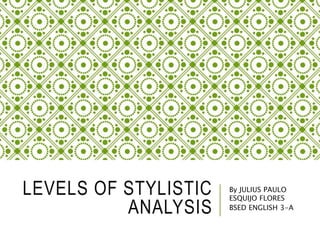
Levels of stylistic analysis
- 1. LEVELS OF STYLISTIC ANALYSIS By JULIUS PAULO ESQUIJO FLORES BSED ENGLISH 3-A
- 2. GRAPHOLOGY It is the study of hand writing. For example as a way of learning more about somebody's character through his writing: contracted forms, commas, stops, question marks etc.
- 3. PHONOLOGY It is the study of sound system of a language and also describes formal rules of pronunciation. The phonological analysis focuses on the analyzing sound patterns, utterance of different words and forming systemic use of sound in language in order to know about the meaning, ideas, focuses and idiosyncratic behaviors in a text. The phonological devices are alliteration, repetition, consonance, assonance etc
- 4. GRAMMATICAL LEVEL 1.Morphological level 2. Syntactic level Grammatical level includes grammar, parts of speech, clauses and phrases used in writing. It helps us to find out subtleties of time, place and about what is done, what is going to be and what was in the past. Through grammatical analysis of text we can know the author’s intended meanings and foreshadowing meanings and events.
- 5. LEXICAL Lexical are total amount of vocabulary items and use of words in a piece of text. Lexical level: it includes the study of individual words and idioms in different linguistics contexts. It involves the study of semantics, word formation, and morphology.
- 6. SEMANTICS Semantics is the study of, meanings in a language. Meanings are judged through the analysis of context, social and individual point of views. Pragmatics is also a branch of semantics which allow us to find out the hidden meanings to be judged by the reader through the environment created by the poet in a poem.
- 7. PRAGMATICS Pragmatics is the study of invisible meaning in a piece of text spoken or written. It discusses how we recognize the invisible meanings in a text. It is the context based study including linguistic context, thematic context, pre-existing knowledge and physical context of the text.
- 8. DISCOURSE ANALYSIS It is the study of text language and conversations. When we concentrate in linguistic description we focus on accurate representation of form and meaning within the text. It also provides us chance to create a complex interpretation of a simple discourse and simple interpretation of a complex language in order to facilitate the readers.
- 9. EXAMPLES OF GRAPHOLOGICAL FEATURES: 1. Rhyme scheme 2. Hyphens 3. Unusual capitalization 4. Frequent use of a particular word/s 5. Contractions/ contracted forms 6. Punctuations 7. Spelling
- 10. PHONOLOGICAL FEATURES End rhyme Alliteration Assonance Onomatopoeic words Tone of the author
- 11. GRAMMATICAL FEATURES Structural and lexical features -Word classes or parts of speech -Nouns to interjections -Use of verbals -Coinages -Unfamiliar expressions -Connotations -Colloquial references -Compounding
- 12. PRAGMATIC FEATURES Quotations Deixis -these are some expressions that cannot be understood without the knowledge of context and physical context of speaker. Person deixis: These are used to point things and people. Examples of person deixis are : “Whose, her, his ,their ,him, this” Temporal deixis: They point to time. Examples: “whole time, till, then, soon” Spatial deixis: They are used to point location. Examples are where, there, here, etc
- 13. PRAGMATIC FEATURES Inference: it is more dependent upon the reader’s ability to understand the things than his dictionary knowledge of words and language. Anaphora: when we refer back to the situation, things, person, events. Cataphora: refers to an expression or subject which is used afterward. Repetition: a device that repeats the same words or phrases a few times to make an idea clearer.
- 14. Presuppositions: an implicit assumption about the world or background belief relating to an utterance whose truth is taken for granted in discourse. Eg. Jane no longer writes fiction. This statement presupposes that Jane wrote fiction before.
- 15. WORD FREQUENCY It includes the words that are repeated more than one time in the literary piece. These more than one time occurrences may help in developing the understanding of reader.RANK FREQUENCY WORD 1 10 The 2 8 Love 3 5 I
- 16. LITERARY DEVICES AND TECHNIQUES Figures of speech
